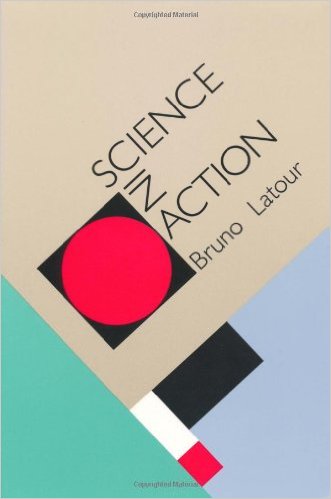Book Review: Science in Action
Science in Action:
How to Follow Scientists and Engineers Through Society
by Bruno Latour
Review by John Wright
Bruno Latour’s book, Science in Action: How to Follow Scientists and Engineers Through Society, evoked controversy in 1987 when it was first published by Harvard University Press, as it still does today, twenty-five years later. Latour, a French scholar of an emerging field called “science studies,” followed scientists around their work spaces in order to understand and describe how they work.
He explains that “science” is not the simple application of an abstract, universal reason to unmask a previously existing “nature” beyond human beliefs. Rather, science always results from ongoing uncertainty and controversies behind the scenes: “Science has two faces: one that knows, the other that does not know yet.”
Latour calls the side that “knows” a “black box”—an instrument, or finding, or agreed-upon position that becomes the basis of future work. Latour’s account of science from “following the scientists” stands at the transition point between the science that knows and the science that does not know yet. He invites us to observe how movement happens back and forth across this divide between scientific controversy and the assured results of scientific research.
Scientists work embedded in particular, local, embodied, historical, and contingent networks. The active agents of these networks are not merely the humans; part of the wonder of science is that it allows non-humans to push back and act on humans. In this complex interaction, non-humans become agents shaping the behavior of the scientists, as the scientists and various non-humans seek to strengthen the network that holds them together with non-humans. Science achieves its strength from its placement within extensive and complex networks. The word “network” indicates that resources are concentrated in knots and nodes which are connected with one another.
Latour’s underlying insight is that scientific results are (1) socially constructed, (2) real, and (3) never absolute. Scientific results last longer the better they are constructed and the more deeply they are enmeshed in networks of humans and non-humans. For example, both a lean-to in the woods and York Cathedral in England are socially constructed and real, yet the cathedral required a much larger network of humans and non-humans in the elegance and firmness of its construction.
Latour’s account provides important lessons for Christians. First, we cannot merely dismiss scientific findings, nor can we absolutize them into eternal monuments of things in themselves. Science is the various local networks that allow non-humans to push back against humans in ways that humans must respond. Secondly, Latour helps us see the knots and nodes within intersecting networks and how persons can attempt to use these nodes to strengthen networks to which they are committed. Third, Latour shows us that faith and science are not dichotomies, but intricately related.
All “science” requires trust/belief/faith in order for the networks to form, function, and stay together. “Belief” activates the skills necessary to pull humans and non-humans into a network that allows “science” to take place. “Science” allows non-humans to influence humans directly to sustain their network. Ultimately, the issue is not “belief” versus “science;” the issue is who or what is the Lord of your network. Where is its ultimate end? Although various networks intersect at various nodes, ultimately a network’s beginning and end, the from whom, and through whom, and for whom the network is drawn, will make a profound difference in what the network is able to hold together in an alliance of humans and non-humans. And Latour helpfully reminds readers that “science has two faces: one that knows, the other that does not know yet.”

